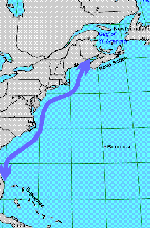
Today's News

Spring's Journey North

Report Your Sightings

Search Journey North
return to:

 A/CPB
A/CPB
Right Whale Migration Update: February 4, 1998
Right Whale Migration Updates Will be Posted on WEDNESDAYS:
Feb. 4, 18, Mar. 4, 18, Apr. 1, 15, 29, May 12, 26
Ahoy there. This is Anne Smrcina, education coordinator of the Stellwagen
Bank National Marine Sanctuary in Plymouth, MA with the first right whale and humpback whale reports. These
reports will be coming to you every two weeks according to the schedule above -- unless I get some really exciting
news that can't wait.
 |
|
Migration Route of North Atlantic Right Whales Map courtesy of |
It is here in these warm, shallow areas that calving takes place, in an area relatively free from predatory orcas, also known as killer whales. Orcas have been known to target newborn and juvenile baleen whales -- in California they sometimes form a gauntlet through which gray whales have to pass.
We know that the female right whales calve in this stretch of coastal water, the only known calving ground for the most endangered of the great whales. Scientists estimate that there are only about 300 or so northern right whales in the North Atlantic population. (There are several thousand southern right whales but they are considered a separate species.)
Although we know where the pregnant females (or at least most of them) go, we still don't know where all the others spend their time during the winter.
Some juveniles seem to make the trek to the Florida coast too (perhaps because they haven't learned where else to go). On other occasions it seems that nonpregnant females may be accompanying pregnant females. And once in a while, a large adult male is seen.
Scientists hope to be able to apply satellite tags and follow the winter migrations of these "missing" groups -- nonpregnant females, males and juveniles.
Some of these animals may not actually make a long distance migration at all. Over the past several weeks right whales have been spotted in Cape Cod Bay --just a short distance from the Stellwagen Bank Sanctuary. On Feb. 3rd, 21
whales were spotted in Cape Cod Bay. The general vicinity for this whale concentration is: 41 50N, 70 10W
The Bay and Bank are regular feeding grounds during February-April, but it seems that some of the whales may be making an early start at chowing down on copepods (small crustaceans) in these productive waters. Researchers
from the Center for Coastal Studies have been making regular aerial flights to locate these whales and photograph them. They will be starting the eye-straining process of trying to identify these whales from the photographs over the next few days. Hopefully in my next report I'll have some names (or in the case with many nameless right whales just their catalog numbers).
Here's a Challenge Question for you! Many of you may know that humpback whales are identified by the black and white patterns on their flukes. Each whale has a unique pattern, just like a fingerprint. But all right whales have solid black flukes.
Challenge Question #1:
"How do you think researchers identify individual right whales?"
(To respond to this Challenge Question, please follow the instructions at the end of this report)
Down in the calving grounds aerial overflights by the New England Aquarium have located what appears to be 10 mother-calf
pairs. This is a good number for this early in the season, and scientists are hopeful for a good calving year.
Sadly, they did also spot a dead calf several miles east of Brunswick, GA. With the help of the Coast Guard,
the scientists were able to tow the carcass back to shore where a necropsy (an animal autopsy) was performed.
This investigation indicated that the whale probably died from natural complications from birth -- perhaps an inexperienced
first-time mother.
For the record, here are some of the most recent whale sightings off the southeastern U.S. coast (Jan. 13):
mother-calf pair 30 28N, 81 23W
5 adults or juveniles 30 12N, 81 11W
mother-calf pair 30 31N, 81 15W
The first mother-calf sighting of the season was made by a harbor pilot near Savannah on Dec. 12.
For detailed reports from the New England Aquarium Right Whale Research Group down in Florida and for up-to-date
Northeast Right Whale Alerts from the National Marine Fisheries Service, check out the WhaleNet
page on the World Wide Web. This site has a wealth of information about right whales and whales in general.
I'll have more information Right Whales for you in two weeks. Let's hope for a healthy and productive whale season.
Anne Smrcina
Education Coordinator
Stellwagen Bank National Marine Sanctuary
How to Respond to Journey North Right Whale Challenge Question # 1
1. Address an e-mail message to: jn-challenge-rwhale@learner.org
2. In the Subject Line of your message write: Challenge Question # 1
3. In the body of the message, give your answer to this question:
Challenge Question #1:
"How do you think researchers identify individual right whales?"
The Next Right Whale Update will Be Posted on February 18, 1998.



